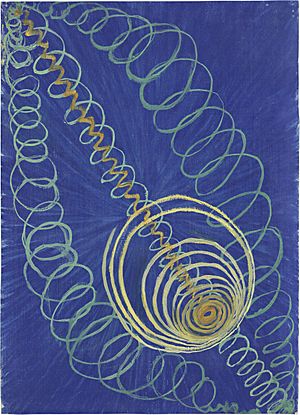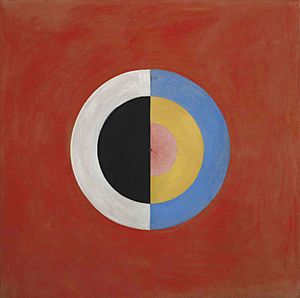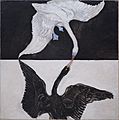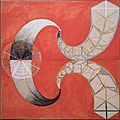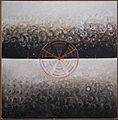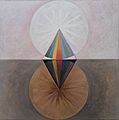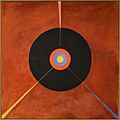Hilma af Klint facts for kids
Quick facts for kids
Hilma af Klint
|
|
|---|---|

Portrait photograph c. 1901 or earlier
|
|
| Born | 26 October 1862 Karlberg Palace
|
| Died | 21 October 1944 (aged 81) |
| Resting place | Galärvarvskyrkogården, Stockholm, Sweden |
| Nationality | Swedish |
| Education | Tekniska skolan, Royal Swedish Academy of Arts |
| Known for | Painting |
| Movement | naturalism, abstract art |
Hilma af Klint (born October 26, 1862 – died October 21, 1944) was a Swedish artist. She was also a mystic, meaning she explored spiritual ideas and hidden meanings. Her paintings are thought to be some of the very first abstract artworks in Western art history.
Abstract art doesn't show things as they look in real life. Instead, it uses shapes, colors, and lines to express feelings or ideas. Hilma af Klint created many abstract paintings before other famous artists like Wassily Kandinsky, Kazimir Malevich, and Piet Mondrian.
Hilma was part of a group called "The Five." These were five women who believed in Theosophy, a spiritual philosophy. They tried to connect with "High Masters," who they believed were wise spirits, often through special meetings called séances. Hilma's paintings often looked like diagrams. They were her way of showing complex spiritual ideas visually.
Contents
Hilma's Early Life
Hilma af Klint was the fourth child in her family. Her father, Victor af Klint, was a Swedish naval commander. She spent her summers at the family's home, "Hanmora," on Adelsö island in Lake Mälaren. Being in nature so much helped her connect deeply with natural forms. This connection later inspired her artwork.
Hilma inherited a strong interest in mathematics and botany (the study of plants) from her family. She showed a talent for art early on. After her family moved to Stockholm, she studied at Tekniska skolan (now Konstfack). There, she learned how to paint portraits and landscapes.
At age twenty, she was accepted into the Royal Academy of Fine Arts. From 1882 to 1887, she focused on drawing, portraits, and landscapes. She graduated with honors and received a studio space in central Stockholm. This area was a big cultural center at the time. Hilma became known for her landscapes, plant drawings, and portraits. These traditional paintings helped her earn money. However, her most important work, her abstract art, was kept separate and private.
Spiritual Ideas and Art
In 1880, Hilma's younger sister, Hermina, died. This event led Hilma to explore spiritual ideas more deeply. Her interest in abstract art and symbols came from her involvement in spiritism. This was very popular in the late 1800s and early 1900s. She began her spiritual studies in 1879.
She became interested in Theosophy, a spiritual movement started by Helena Blavatsky. In 1908, she met Rudolf Steiner, who founded the Anthroposophical Society. Steiner shared his ideas about art, which later influenced her paintings. She visited him again in Switzerland in 1920 and spent long periods there.
Hilma af Klint's art fits into a larger trend of artists at the time looking for new ways to express themselves. Many artists, including Kandinsky and Mondrian, were also interested in spirituality. Hilma's work was mainly spiritual, and her art grew from these beliefs.
She felt her abstract work was so new and important that the world wasn't ready for it. So, she asked for her abstract paintings to be kept secret for 20 years after her death.
Her Unique Artwork
At the Academy of Fine Arts, Hilma met Anna Cassel. Anna was one of the four women who later joined Hilma to form "The Five" (De Fem). The other members were Cornelia Cederberg, Sigrid Hedman, and Mathilda Nilsson.
"The Five" started as part of the Edelweiss Society. They combined Theosophy with spiritism. All five women were interested in the paranormal and held regular séances. They would pray, meditate, and discuss spiritual texts. Then, they would have a séance to receive messages from spirits they called "The High Masters." They wrote down a new system of mystical ideas from these messages.
Through "The Five," Hilma af Klint began creating experimental automatic drawings as early as 1896. This means she let her hand move freely, guided by her spiritual connection. This led her to develop a unique visual language using shapes and lines. She used this language to show invisible forces from both the inner and outer worlds.
She studied different religions, atoms, and plants. She wrote many notes about her discoveries. The High Masters asked her to create paintings for a "Temple." She never fully understood what this "Temple" was. Hilma felt a force guided her hand as she painted.
In 1906, at age 44, Hilma af Klint painted her first series of abstract works. These were the "Paintings for the Temple."
The "Temple" paintings were made between 1906 and 1915. Hilma developed a new artistic style during this time. Her painting became more independent and purposeful. Spirituality remained her main source of creativity for the rest of her life.
The "Temple" collection includes 193 paintings, divided into several smaller series. Some of the main paintings from 1907 are very large, about 240 x 320 cm (about 8 x 10.5 feet). This series, called The Ten Largest, shows different stages of life, from childhood to old age.
Her paintings are full of symbols, letters, and words. They often show opposite ideas, like up and down, inside and out, or male and female. The colors she used also had special meanings:
- Blue meant the female spirit.
- Yellow meant the male spirit.
- Pink or red meant physical or spiritual love.
Series names like The Swan and The Dove were also symbolic. The Swan represented moving beyond the physical world, and The Dove represented love. Her paintings invite viewers to think about stories, hidden meanings, and art itself. They use basic shapes and human ideas.
After finishing the "Temple" works, Hilma's spiritual guidance ended. But she kept painting abstract art, now on her own. She used watercolors more often, and her later paintings were smaller. She explored different religions and the idea of a physical self versus a spiritual self. She also seemed inspired by the art theories of the Anthroposophical Society after 1920.
Hilma af Klint spent her life trying to understand the mysteries she found through her art. She filled more than 150 notebooks with her thoughts and studies.
In 1908, Hilma met Rudolf Steiner. She asked him to see her "Temple" paintings. Steiner saw them but was not very impressed. He felt her method of working was not right for a Theosophist. He also said that people at the time would not understand her paintings. He thought it would take 50 years for them to be understood. Steiner did keep photos of some of her artworks. Some art historians think that Wassily Kandinsky might have seen these photos and been influenced by them.
Hilma af Klint decided to destroy all her letters later in life. She left over 1200 paintings and 125 diaries to her nephew, Erik af Klint. Among her last paintings from the 1930s are two watercolors that seemed to predict events of World War II. They are called The Blitz and The Fight in the Mediterranean.
Many people believed Hilma af Klint never showed her abstract art during her lifetime. However, recent discoveries by art historians like Julia Voss show that Hilma did try to exhibit her work. In 1928, she traveled to London with some of her large paintings for a spiritual science conference. She wrote in a postcard that she was not alone on this trip. It is believed she showed some of her "Paintings for the Temple" there.
Hilma af Klint died in Sweden in 1944, at almost 82 years old, after a traffic accident. She had only shown her abstract works a few times, mostly at spiritual gatherings. She is buried in Stockholm.
Hilma's Art Style
Hilma af Klint's abstract art from 1906 to 1920 used symbols. It combined geometry, figures, scientific ideas, and spiritual practices. She studied how plants and shells grow. This helped her show life through a spiritual viewpoint.
Her unique style also showed influences from scientific discoveries of her time. Spiritual movements like Theosophy and Anthroposophy also shaped her art. She wanted to go beyond showing the physical world in her abstract paintings.
Her symbolic visual language followed an organized pattern. It used grids, circles, spirals, and petal-like shapes. Sometimes they looked like diagrams, and sometimes like living forms. Her paintings also explored opposite ideas in the world.
Spiral shapes often appear in her art, just as they did in the automatic drawings of "The Five." Spirals suggest growth, progress, and change. Her color choices also had symbolic meanings.
As one of the early female artists who challenged traditional art, her style shows a sense of the "sublime" in art. This means it creates a feeling of awe and wonder.
Hilma's Legacy
In her will, Hilma af Klint left all her abstract paintings to her nephew, Erik af Klint. She asked that her work be kept secret for at least 20 years after her death. When the boxes were opened in the late 1960s, very few people knew what they would find.
In 1970, her paintings were offered to the Moderna Museet in Stockholm, but they were not accepted. Erik af Klint then gave thousands of drawings and paintings to a foundation named after the artist in the 1970s. Thanks to art historian Åke Fant, her art was shown to people around the world in the 1980s. He presented her work at a conference in Helsinki in 1984.
The collection of Hilma af Klint's abstract paintings has over 1200 pieces. The Hilma af Klint Foundation in Stockholm, Sweden, owns and manages it. In 2018, the Foundation made a long-term agreement with the Moderna Museet. This means there will always be a special "Hilma af Klint Room" at the museum. About a dozen of her works are always on display there.
Exhibitions (After Her Death)
Hilma af Klint's abstract work was first shown to the public at an exhibition called "The Spiritual in Art, Abstract Painting 1890–1985." This show was organized by Maurice Tuchman in Los Angeles in 1986. This exhibition helped her gain international recognition.
One of her most popular exhibitions was "Hilma Af Klint: Paintings for the Future" at the Solomon R. Guggenheim Museum in New York. It was the most visited exhibition in the museum's 60-year history, with over 600,000 visitors.
Some Important Exhibitions
- The Spiritual in Art: Abstract Painting 1890–1985, Los Angeles County Museum of Art, USA. 1986–1987.
- The Secret Pictures by Hilma af Klint, MoMA PS1, New York. 1989.
- Ockult målarinna och abstrakt pionjär (Occult Painter and Abstract Pioneer), Moderna Museet i Stockholm, Sweden. 1989–1991.
- Målningarna till templet (The paintings to the Temple), Liljevalchs konsthall, Stockholm, Sweden. 1999–2000.
- Hilma af Klint – a Pioneer of Abstraction, Moderna Museet i Stockholm, Sweden. 2013. This exhibition then traveled to Berlin, Málaga, Copenhagen, Oslo, and Tallinn.
- Works by af Klint were shown at the 55th Venice Biennale, Italy. 2013.
- Painting the Unseen, Serpentine Galleries, London, UK. 2016.
- Hilma af Klint: Paintings for the Future, Solomon R. Guggenheim Museum, New York, USA. 2018–2019.
- Hilma af Klint: The Secret Paintings, Art Gallery of New South Wales, Australia. 2021.
Gallery
See also
 In Spanish: Hilma af Klint para niños
In Spanish: Hilma af Klint para niños
- Hilma af Klint and Theosophy




